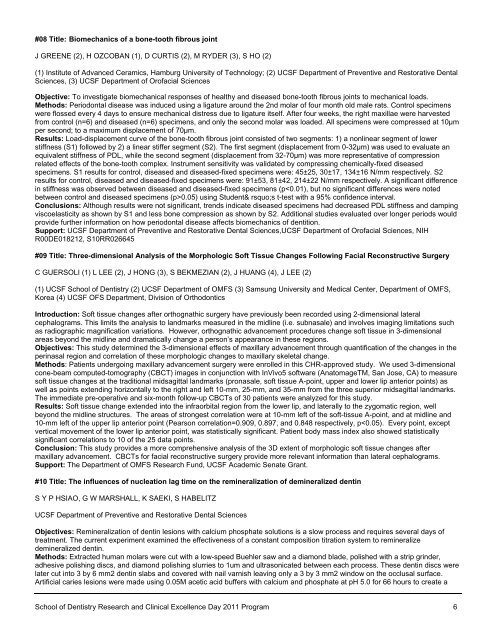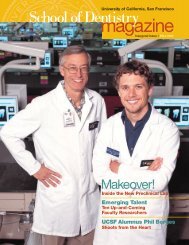Acknowledgements - UCSF School of Dentistry - University of ...
Acknowledgements - UCSF School of Dentistry - University of ...
Acknowledgements - UCSF School of Dentistry - University of ...
Create successful ePaper yourself
Turn your PDF publications into a flip-book with our unique Google optimized e-Paper software.
#08 Title: Biomechanics <strong>of</strong> a bone-tooth fibrous joint<br />
J GREENE (2), H OZCOBAN (1), D CURTIS (2), M RYDER (3), S HO (2)<br />
(1) Institute <strong>of</strong> Advanced Ceramics, Hamburg <strong>University</strong> <strong>of</strong> Technology; (2) <strong>UCSF</strong> Department <strong>of</strong> Preventive and Restorative Dental<br />
Sciences, (3) <strong>UCSF</strong> Department <strong>of</strong> Or<strong>of</strong>acial Sciences<br />
Objective: To investigate biomechanical responses <strong>of</strong> healthy and diseased bone-tooth fibrous joints to mechanical loads.<br />
Methods: Periodontal disease was induced using a ligature around the 2nd molar <strong>of</strong> four month old male rats. Control specimens<br />
were flossed every 4 days to ensure mechanical distress due to ligature itself. After four weeks, the right maxillae were harvested<br />
from control (n=6) and diseased (n=6) specimens, and only the second molar was loaded. All specimens were compressed at 10µm<br />
per second; to a maximum displacement <strong>of</strong> 70µm.<br />
Results: Load-displacement curve <strong>of</strong> the bone-tooth fibrous joint consisted <strong>of</strong> two segments: 1) a nonlinear segment <strong>of</strong> lower<br />
stiffness (S1) followed by 2) a linear stiffer segment (S2). The first segment (displacement from 0-32μm) was used to evaluate an<br />
equivalent stiffness <strong>of</strong> PDL, while the second segment (displacement from 32-70μm) was more representative <strong>of</strong> compression<br />
related effects <strong>of</strong> the bone-tooth complex. Instrument sensitivity was validated by compressing chemically-fixed diseased<br />
specimens. S1 results for control, diseased and diseased-fixed specimens were: 45±25, 30±17, 134±16 N/mm respectively. S2<br />
results for control, diseased and diseased-fixed specimens were: 91±53, 81±42, 214±22 N/mm respectively. A significant difference<br />
in stiffness was observed between diseased and diseased-fixed specimens (p0.05) using Student& rsquo;s t-test with a 95% confidence interval.<br />
Conclusions: Although results were not significant, trends indicate diseased specimens had decreased PDL stiffness and damping<br />
viscoelasticity as shown by S1 and less bone compression as shown by S2. Additional studies evaluated over longer periods would<br />
provide further information on how periodontal disease affects biomechanics <strong>of</strong> dentition.<br />
Support: <strong>UCSF</strong> Department <strong>of</strong> Preventive and Restorative Dental Sciences,<strong>UCSF</strong> Department <strong>of</strong> Or<strong>of</strong>acial Sciences, NIH<br />
R00DE018212, S10RR026645<br />
#09 Title: Three-dimensional Analysis <strong>of</strong> the Morphologic S<strong>of</strong>t Tissue Changes Following Facial Reconstructive Surgery<br />
C GUERSOLI (1) L LEE (2), J HONG (3), S BEKMEZIAN (2), J HUANG (4), J LEE (2)<br />
(1) <strong>UCSF</strong> <strong>School</strong> <strong>of</strong> <strong>Dentistry</strong> (2) <strong>UCSF</strong> Department <strong>of</strong> OMFS (3) Samsung <strong>University</strong> and Medical Center, Department <strong>of</strong> OMFS,<br />
Korea (4) <strong>UCSF</strong> OFS Department, Division <strong>of</strong> Orthodontics<br />
Introduction: S<strong>of</strong>t tissue changes after orthognathic surgery have previously been recorded using 2-dimensional lateral<br />
cephalograms. This limits the analysis to landmarks measured in the midline (i.e. subnasale) and involves imaging limitations such<br />
as radiographic magnification variations. However, orthognathic advancement procedures change s<strong>of</strong>t tissue in 3-dimensional<br />
areas beyond the midline and dramatically change a person’s appearance in these regions.<br />
Objectives: This study determined the 3-dimensional effects <strong>of</strong> maxillary advancement through quantification <strong>of</strong> the changes in the<br />
perinasal region and correlation <strong>of</strong> these morphologic changes to maxillary skeletal change.<br />
Methods: Patients undergoing maxillary advancement surgery were enrolled in this CHR-approved study. We used 3-dimensional<br />
cone-beam computed-tomography (CBCT) images in conjunction with InVivo5 s<strong>of</strong>tware (AnatomageTM, San Jose, CA) to measure<br />
s<strong>of</strong>t tissue changes at the traditional midsagittal landmarks (pronasale, s<strong>of</strong>t tissue A-point, upper and lower lip anterior points) as<br />
well as points extending horizontally to the right and left 10-mm, 25-mm, and 35-mm from the three superior midsagittal landmarks.<br />
The immediate pre-operative and six-month follow-up CBCTs <strong>of</strong> 30 patients were analyzed for this study.<br />
Results: S<strong>of</strong>t tissue change extended into the infraorbital region from the lower lip, and laterally to the zygomatic region, well<br />
beyond the midline structures. The areas <strong>of</strong> strongest correlation were at 10-mm left <strong>of</strong> the s<strong>of</strong>t-tissue A-point, and at midline and<br />
10-mm left <strong>of</strong> the upper lip anterior point (Pearson correlation=0.909, 0.897, and 0.848 respectively, p




